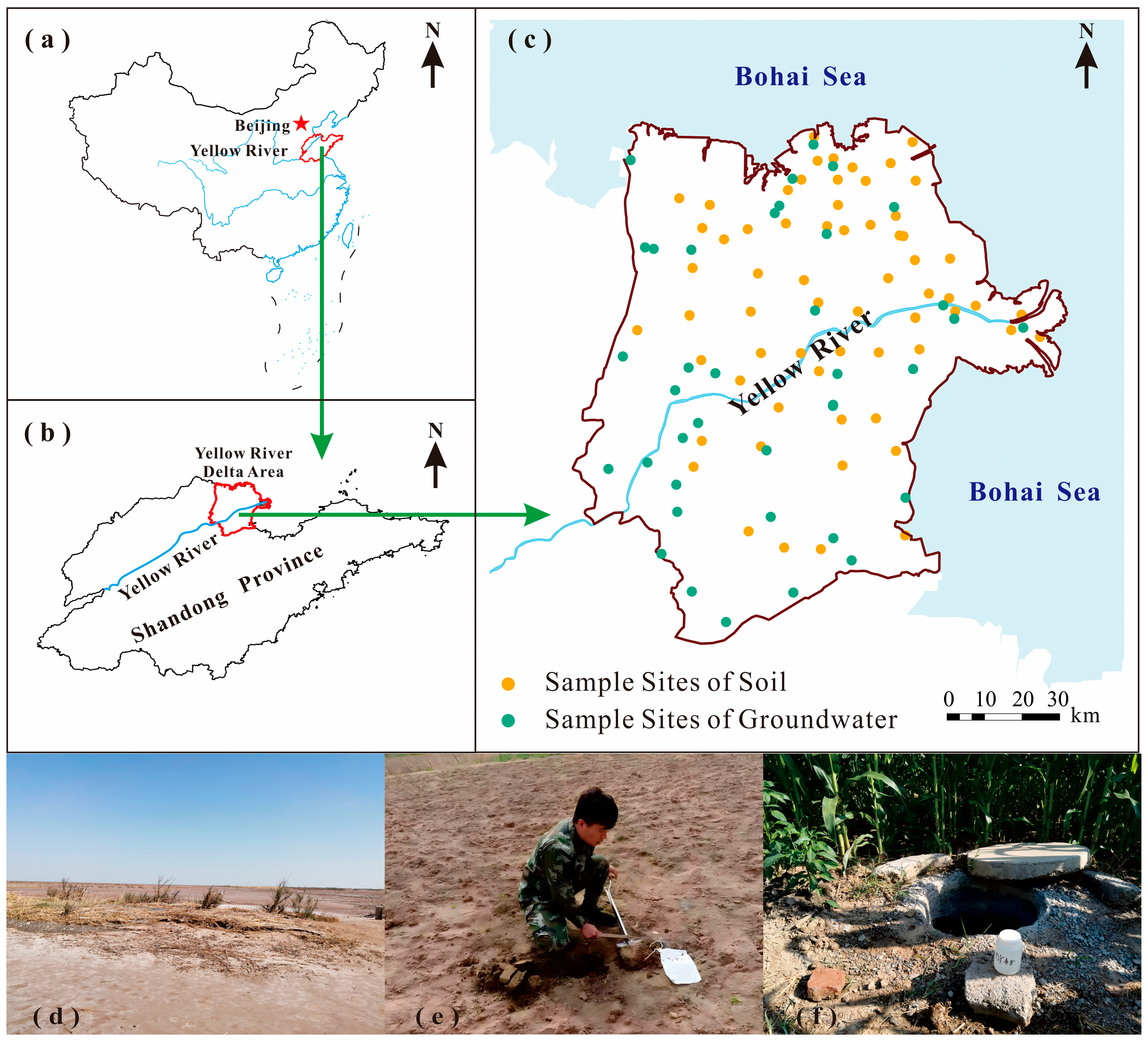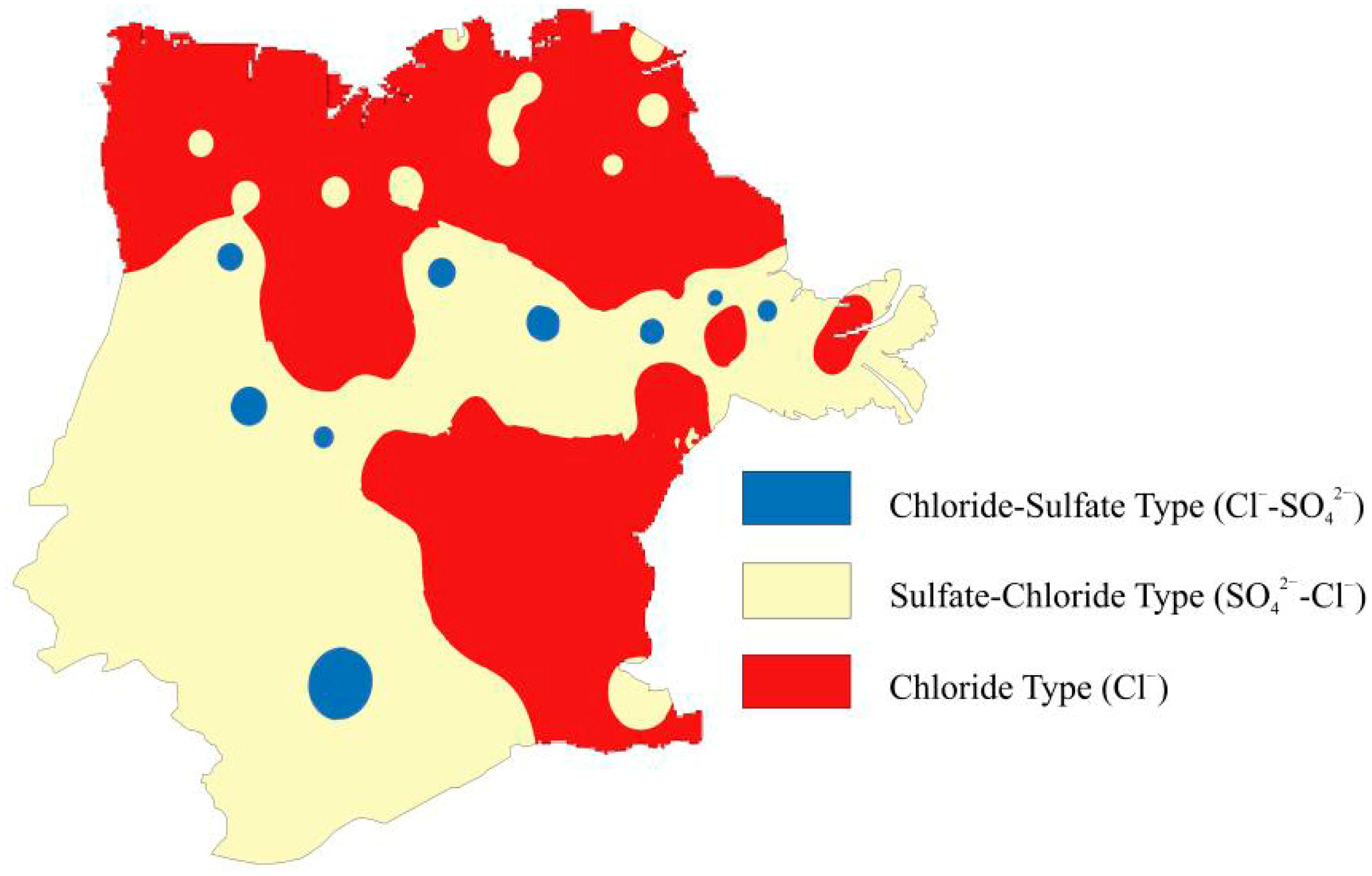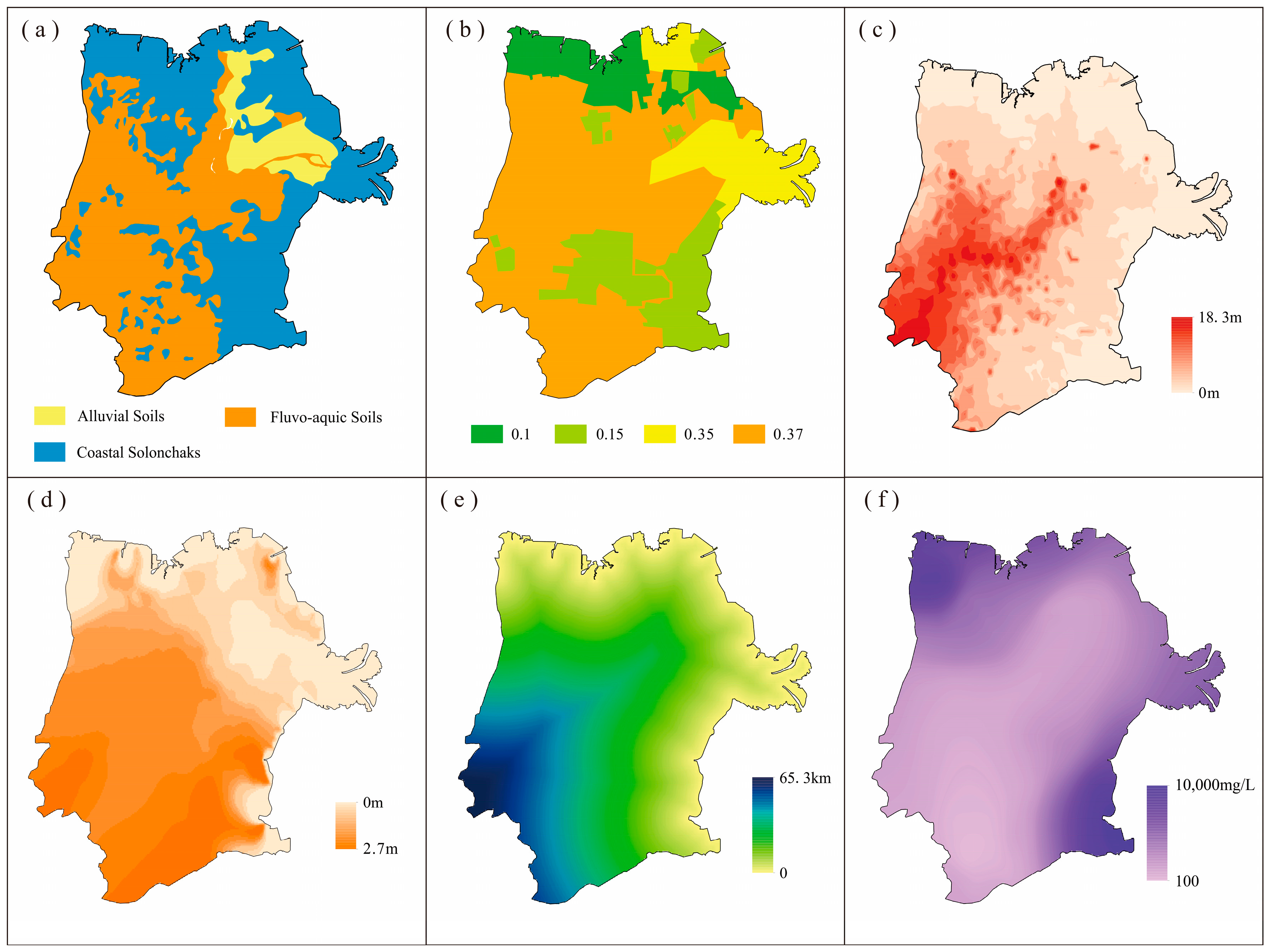Characteristics and Risk Assessment of Soil Salinization in the Yellow River Delta Region, China
Abstract
1. Introduction
2. Materials and Methods
2.1. Study Area
2.2. Sample Collection and Test Method
2.2.1. Sample Collection
2.2.2. Test Method
2.3. Methods of Assessment
2.3.1. Types of Soil Salinization
2.3.2. Degree of Soil Salinization
2.3.3. Risk Assessment of Soil Salinization
2.4. Statistical Analysis
3. Results
3.1. Distribution Characteristics of Soil Salinity
3.1.1. Descriptive Statistical Analysis
3.1.2. Zoning of Soil Salinization Types
3.1.3. Zoning of Soil Salinization Degree
3.2. Hydrochemical Characteristics
3.2.1. Piper Diagram
3.2.2. Gibbs Diagram
3.3. Influencing Factors Analysis and Risk Assessment of Soil Salinization
3.3.1. Analysis of Influencing Factors of Soil Salt Content
3.3.2. Risk Assessment of Soil Salinization in the Yellow River Delta Region
4. Discussion
5. Conclusions
- (1)
- The average salt content in the soil of the Yellow River Delta region was 4.59 g/kg, indicating a relatively high salinity overall. The dominant cation in the soil was Na+, comprising 71.03% of the total cation concentration, while the dominant anion was Cl−, accounting for 72.97% of the total anion concentration. The primary types of soil salinization were chloride type and sulfate-chloride type in the study area, representing 46.69% and 51.54% of the total area, respectively. The degree of soil salinization was predominantly moderate, accounting for 45.35% of the area. Extremely severe salinization and severe salinization were mainly distributed in the coastal lowlands in the northern and eastern parts of this region, covering 19.73% and 16.25% of the area, respectively.
- (2)
- The results of the Piper and Gibbs diagrams indicated that the groundwater chemical types in most areas of the Yellow River Delta were in a transitional stage between freshwater and saltwater, while a few areas had already become saline. This suggested that the entire study area had been affected by seawater intrusion, with some areas experiencing more severe impacts. Therefore, seawater intrusion in this region was a significant factor contributing to the increased salt content in the soil and played a crucial role in soil salinization.
- (3)
- Based on the results of both correlation and influence analyses, the factors affecting soil salt content in the Yellow River Delta region, ranked from greatest to least impact, were: Dis > TDS > DEM > ST > Dep > ET. These findings indicated that the primary cause of soil salinization in the Yellow River Delta was seawater intrusion.
- (4)
- The results of the risk assessment for soil salinization in the Yellow River Delta region indicated that areas with high risk and medium–high risk accounted for a significant proportion, exceeding 52%. The distance from the Bohai Sea was the most influential factor, demonstrating a clear trend: the closer the area was to the Bohai Sea, the higher the risk of soil salinization. It is recommended to enhance the monitoring of soil salt content in the Yellow River Delta region and implement appropriate measures to control soil salinization.
- (5)
- All these findings above can provide valuable references for local wetland management and protection, the scientific enhancement of saline soils, rational soil utilization, effective prevention and control of soil salinization, and the sustainable development of water and soil resources.
Author Contributions
Funding
Data Availability Statement
Conflicts of Interest
References
- Khadija, Z.; Latifa, M.; Abdelaziz, M.; Khattabi, R.S.; Ilham, N.; Salah, S. Soil metal pollution in freeway traffic (Mohammedia-Bouznika section, Morocco). Int. J. Environ. Sci. Technol. 2025, 22, 1385–1402. [Google Scholar] [CrossRef]
- Wu, J.; Li, P.; Qian, H.; Fang, Y. Assessment of soil salinization based on a low-cost method and its influencing factors in a semiarid agricultural area, northwest China. Environ. Earth Sci. 2014, 71, 3465–3475. [Google Scholar] [CrossRef]
- Li, D.; Wu, W.; Zhu, H.; Guo, W.; Liu, Y.; Li, N. Complex Resistivity Dispersion for Monitoring Soil Contaminated by Selected Organic Pollutants. Environ. Res. 2025, 279, 121756. [Google Scholar] [CrossRef] [PubMed]
- Fang, S.; Hua, C.; Yang, J.; Liu, F.; Wang, L.; Wu, D.; Ren, L. Combined pollution of soil by heavy metals, microplastics, and pesticides: Mechanisms and anthropogenic drivers. J. Hazard. Mater. 2025, 485, 136812. [Google Scholar] [CrossRef]
- Hou, D.; Jia, X.; Wang, L.; McGrath, S.P.; Zhu, Y.; Hu, Q.; Zhao, F.; Bank, M.S.; O’Connor, D.; Nriagu, J. Global soil pollution by toxic metals threatens agriculture and human health. Science 2025, 388, 316–321. [Google Scholar] [CrossRef]
- Yu, Y.; Liu, Y.; Zhao, Z.; Cui, H. An Auxiliary Method for Evaluating Soil Erosion and Pollution by Magnetic Susceptibility on Black Soil Farmland. Water Air Soil Pollut. 2025, 236, 1–14. [Google Scholar] [CrossRef]
- Shrivastava, P.; Kumar, R. Soil salinity: A serious environmental issue and plant growth promoting bacteria as one of the tools for its alleviation. Saudi J. Biol. Sci. 2015, 22, 123–131. [Google Scholar] [CrossRef] [PubMed]
- Song, Y.; Sun, J.; Cai, M.; Li, J.; Bi, M.; Gao, M. Effects of management of plastic and straw mulching management on crop yield and soil salinity in saline-alkaline soils of China: A meta-analysis. Agric. Water Manag. 2025, 308, 109309. [Google Scholar] [CrossRef]
- Xiao, Y.; Zhao, G.; Li, T.; Zhou, X.; Li, J. Soil salinization of cultivated land in Shandong Province, China-Dynamics during the past 40 years. Land Degrad. Dev. 2019, 30, 426–436. [Google Scholar] [CrossRef]
- Anna, O.C.; Jin, L. Chemical and hydrological controls on salt accumulation in irrigated soils of southwestern US. Geoderma 2021, 391, 114976. [Google Scholar] [CrossRef]
- Mao, J.; Wu, J.; Liu, Y.; Guo, C.; Xiao, C.; Lu, Y.; Zhao, L.; Zhang, R.; Zhang, H. A model for simulating evaporation from seasonally frozen saline soil. J. Hydrol. 2025, 659, 133259. [Google Scholar] [CrossRef]
- Feng, H.; Xing, X.; Xing, J.; Du, J.; Li, D. Performance and modeling of infiltration flow in cracked saline soils. J. Hydrol. 2025, 656, 133054. [Google Scholar] [CrossRef]
- Xie, X.; Pu, L.; Zhu, M.; Xu, Y.; Wang, X. Linkage between soil salinization indicators and physicochemical properties in a long-term intensive agricultural coastal reclamation area, Eastern China. J. Soils Sediments 2019, 19, 3699–3707. [Google Scholar] [CrossRef]
- Wang, Y.; Deng, C.; Liu, Y.; Niu, Z.; Li, Y. Identifying change in spatial accumulation of soil salinity in an inland river watershed, China. Sci. Total Environ. 2018, 621, 177–185. [Google Scholar] [CrossRef]
- Ajay, S. Soil salinization management for sustainable development: A review. J. Environ. Manag. 2021, 277, 111383. [Google Scholar] [CrossRef]
- Xia, J.; Ren, J.; Zhang, S.; Wang, Y.; Fang, Y. Forest and grass composite patterns improve the soil quality in the coastal saline-alkali land of the Yellow River Delta, China. Geoderma 2019, 349, 25–35. [Google Scholar] [CrossRef]
- Miao, Q.; Wu, S.; Li, J.; Zhang, J.; Wang, Y.; Wu, G.; Sun, Y.; Ying, H.; Cui, Z. Productivity of saline soils can be improved by integrating soil–crop system management. Eur. J. Agron. 2025, 168, 127618. [Google Scholar] [CrossRef]
- Song, Y.; Gao, M.; Li, Z. Impacts of straw return methods on crop yield, soil organic matter, and salinity in saline-alkali land in North China. Field Crops Res. 2025, 322, 109752. [Google Scholar] [CrossRef]
- Zhang, Y.; Hou, K.; Qian, H.; Gao, Y.; Fang, Y.; Xiao, S.; Tang, S.; Zhang, Q.; Qu, W.; Ren, W. Characterization of soil salinization and its driving factors in a typical irrigation area of northwest China. Sci. Total Environ. 2022, 837, 155808. [Google Scholar] [CrossRef]
- Yang, J.; Zhao, J.; Mao, X.; Zhang, Y.; Hu, F. Applicability analysis of weakly supervised semantic segmentation for identifying salinized soil boundaries. J. Arid. Environ. 2025, 229, 105372. [Google Scholar] [CrossRef]
- Wu, C.; Du, X.; Meng, B.; Guo, H. Characteristics and mechanisms of soil salinization in humid climate areas. J. Hydrol. Reg. Stud. 2025, 60, 102607. [Google Scholar] [CrossRef]
- Thangarasu, T.; Mengash, H.A.; Allafi, R.; Mahgoub, H. Spatial prediction of soil salinity: Remote sensing and machine learning approach. J. South Am. Earth Sci. 2025, 156, 105440. [Google Scholar] [CrossRef]
- Rath, K.M.; Fierer, N.; Murphy, D.V.; Rousk, J. Linking bacterial community composition to soil salinity along environmental gradients. ISME J. 2018, 13, 836–846. [Google Scholar] [CrossRef] [PubMed]
- Zhu, H.; Yang, J.; Li, Y.; Liu, X.; Jin, H.; Li, J.; Yao, R. Effects of Soil Salinity on Nitrification and Ammonia-Oxidizing Microorganisms in Coastal Reclaimed Farmland Soil. J. Soil Sci. Plant Nutr. 2022, 22, 2743–2754. [Google Scholar] [CrossRef]
- Sliti, A.; Singh, V.; Pande, A.; Shin, J.-H. Soil holobiont interplay and its role in protecting plants against salinity stress. Pedosphere 2025, 35, 97–115. [Google Scholar] [CrossRef]
- Wang, J.; Ding, J.; Wang, Y.; Ge, X.; Lizaga, I.; Chen, X. Soil salinization in drylands: Measure, monitor, and manage. Ecol. Indic. 2025, 175, 113608. [Google Scholar] [CrossRef]
- Gharemahmudli, S.; Sadeghi, S.H. Inhibiting soil and water loss in a saline soil through cyanobacterization. Soil Tillage Res. 2025, 248, 106446. [Google Scholar] [CrossRef]
- Mai, Z.; Niu, Z.; Zhao, Y.; Li, P.; Wang, Y.; Lv, Y.; Wang, B.; Zhang, M. Land use and cover change significantly enhanced evapotranspiration in the Yellow River Delta from 2000 to 2023. J. Hydrol. Reg. Stud. 2025, 58, 102220. [Google Scholar] [CrossRef]
- Bian, L.; Wang, J.; Liu, J.; Han, B. Spatiotemporal Changes of Soil Salinization in the Yellow River Delta of China from 2015 to 2019. Sustainability 2021, 13, 822. [Google Scholar] [CrossRef]
- Fang, X.; Liu, Z.; Li, J.; Lai, J.; Gong, H.; Sun, Z.; Ouyang, Z.; Dou, W.; Fa, K. Non-Synergistic Changes in Migration Processes between Soil Salt and Water in the Salt Patch of the Coastal Saline Soil. Agronomy 2023, 13, 2403. [Google Scholar] [CrossRef]
- HY/T 0320-2021; National Technical Committee 283 on Ocean of Standardization Administration of China. Code of Practice for Coastal Soil Salinization Monitoring and Evaluation. Ministry of Natural Resources of the People’s Republic of China: Beijing, China, 2021.
- HJ 964-2018; Ministry of Ecological Environment. Technical Guidelines for Environmental Impact Assessment-Soil Environment (Trial). China Environmental Science Press: Beijing, China, 2018.
- Zhou, D.; Lin, Z.; Liu, L.; Zimmermann, D. Assessing secondary soil salinization risk based on the PSR sustainability framework. J. Environ. Manag. 2013, 128, 642–654. [Google Scholar] [CrossRef]
- Wang, Z.; Zhang, F.; Zhang, X.; Chan, N.W.; Kung, H.-T.; Zhou, X.; Wang, Y. Quantitative Evaluation of Spatial and Temporal Variation of Soil Salinization Risk Using GIS-Based Geostatistical Method. Remote Sens. 2020, 12, 2405. [Google Scholar] [CrossRef]
- Hou, J.; Rusuli, Y. Assessment of Soil Salinization Risk by Remote Sensing-Based Ecological Index (RSEI) in the Bosten Lake Watershed, Xinjiang in Northwest China. Sustainability 2022, 14, 7118. [Google Scholar] [CrossRef]
- Zhao, L.; Wang, Z.; Kong, L.; Zhao, Z.; Geng, B.; Gu, S.; Li, Y.; Han, X.; Liu, S.; Li, B.; et al. Risk assessment of soil heavy metals in mining activity areas: A case study in Eastern Shandong Province, China. Environ. Earth Sci. 2023, 82, 513. [Google Scholar] [CrossRef]
- Piper, A.M. A graphic procedure in the geochemical interpretation of water-analyses. Eos Trans. Am. Geophys. Union 1944, 25, 914–928. [Google Scholar]
- Liu, J.; Gao, Z.; Wang, Z.; Xu, X.; Su, Q.; Wang, S.; Qu, W.; Xing, T. Hydrogeochemical processes and suitability assessment of groundwater in the Jiaodong Peninsula, China. Environ. Monit. Assess. 2020, 192, 1–17. [Google Scholar] [CrossRef]
- Gibbs, R.J. Mechanisms controlling world water chemistry. Science 1970, 170, 1088–1090. [Google Scholar] [CrossRef] [PubMed]
- Kong, L.; Chu, H.; Hou, G.; Zeng, J.; Zhao, L.; Han, X.; Li, Y.; Zhou, F.; Yin, M.; Zhang, X. Characteristics and mechanisms of sea (salt) water intrusion in Laizhou City, Shandong Province, China. Front. Mar. Sci. 2025, 12, 1578175. [Google Scholar] [CrossRef]
- Zhao, L.; Geng, B.; Zhao, M.; Li, B.; Miao, Q.; Liu, S.; Zhao, Z.; Wang, H.; Li, Y.; Jin, W.; et al. Evaluation of Groundwater Quality and Health Risk Assessment During the Dry Season in the Xin’an River Basin, China. Water 2025, 17, 2412. [Google Scholar] [CrossRef]
- Arslan, H.; Demir, Y. Impacts of seawater intrusion on soil salinity and alkalinity in Bafra Plain, Turkey. Environ. Monit. Assess. 2013, 185, 1027–1040. [Google Scholar] [CrossRef] [PubMed]
- Cui, G.; Liu, Y.; Li, X.; Wang, S.; Qu, X.; Wang, L.; Tong, S.; Zhang, M.; Li, X.; Zhang, W. Impacts of groundwater storage variability on soil salinization in a semi-arid agricultural plain. Geoderma 2025, 454, 117162. [Google Scholar] [CrossRef]
- Wang, H.; Wang, Z.; Bai, Y.; Wan, W.; Wang, W.; Wang, K. Risk assessment method for soil secondary salinization based on hydrological frequency analysis. Ecol. Indic. 2025, 176, 113688. [Google Scholar] [CrossRef]







| Types of Soil Salinization | Cl−/SO42− |
|---|---|
| Sulfate type (SO42−) | <0.5 |
| Chloride-sulfate type (Cl−-SO42−) | 0.5–1.0 |
| Sulfate-chloride type (SO42−-Cl−) | 1.0–4.0 |
| Chloride type (Cl−) | >4.0 |
| Soil Salinization Degree | Soil Salt Content (SSC)/(g/kg) |
|---|---|
| No salinization | SSC < 1 |
| Mild salinization | 1 ≤ SSC < 2 |
| Moderate salinization | 2 ≤ SSC < 4 |
| Severe salinization | 4 ≤ SSC < 6 |
| Extremely severe salinization | SSC ≥ 6 |
| Risk of Soil Salinization | Comprehensive Evaluation Index |
|---|---|
| High risk | ≥ 0.7 |
| Medium–high risk | 0.5 ≤ < 0.7 |
| Medium risk | 0.3 ≤ < 0.5 |
| Medium–low risk | 0.1 ≤ < 0.3 |
| Low risk | < 0.1 |
| Unit: g/kg | |||||
|---|---|---|---|---|---|
| Min | Max | Average | Stdev | CV | |
| Ca2+ | 0.001 | 1.55 | 0.23 | 0.32 | 137.53% |
| HCO3− | 0.118 | 0.56 | 0.26 | 0.10 | 40.00% |
| K+ | 0.005 | 0.34 | 0.06 | 0.07 | 124.88% |
| Mg2+ | 0.001 | 1.74 | 0.19 | 0.32 | 168.71% |
| Na+ | 0.010 | 5.11 | 1.18 | 1.35 | 114.53% |
| SO42− | 0.021 | 4.40 | 0.50 | 0.63 | 125.68% |
| Cl− | 0.128 | 6.97 | 2.05 | 1.95 | 94.79% |
| SSC | 0.497 | 14.97 | 4.59 | 3.80 | 82.89% |
| Soil Salinization Types | Area (km2) | Proportion (%) |
|---|---|---|
| Chloride type | 3277.30 | 46.69% |
| Sulfate-chloride type (SO42−-Cl−) | 3617.72 | 51.54% |
| Chloride-sulfate type (Cl−-SO42−) | 124.23 | 1.77% |
| Degree of Soil Salinization | Area (km2) | Proportion (%) |
|---|---|---|
| No salinization | 43.10 | 0.61% |
| Mild salinization | 1268.33 | 18.06% |
| Moderate salinization | 3183.88 | 45.35% |
| Severe salinization | 1141.02 | 16.25% |
| Extremely severe salinization | 1385.40 | 19.73% |
| Influencing Factors | Correlation Index | Weights | q | Weights | Comprehensive Weights | Rank |
|---|---|---|---|---|---|---|
| Dis | −0.551 | 0.22 | 0.929 | 0.29 | 0.26 | 1 |
| TDS | 0.366 | 0.15 | 0.863 | 0.27 | 0.21 | 2 |
| Dem | −0.445 | 0.18 | 0.646 | 0.20 | 0.19 | 3 |
| ST | 0.467 | 0.19 | 0.218 | 0.07 | 0.13 | 4 |
| Dep | −0.273 | 0.11 | 0.421 | 0.13 | 0.12 | 5 |
| ET | −0.349 | 0.14 | 0.139 | 0.04 | 0.09 | 6 |
| Risk of Soil Salinization | Area (km2) | Proportion (%) |
|---|---|---|
| High risk | 2293.10 | 32.67% |
| Medium–high risk | 1362.83 | 19.42% |
| Medium risk | 1433.33 | 20.42% |
| Medium–low risk | 1600.58 | 22.80% |
| Low risk | 329.41 | 4.69% |
Disclaimer/Publisher’s Note: The statements, opinions and data contained in all publications are solely those of the individual author(s) and contributor(s) and not of MDPI and/or the editor(s). MDPI and/or the editor(s) disclaim responsibility for any injury to people or property resulting from any ideas, methods, instructions or products referred to in the content. |
© 2025 by the authors. Licensee MDPI, Basel, Switzerland. This article is an open access article distributed under the terms and conditions of the Creative Commons Attribution (CC BY) license (https://creativecommons.org/licenses/by/4.0/).
Share and Cite
Zhao, L.; Kong, L.; Zhang, X.; Han, X.; Zhao, Z.; Li, B.; Wang, Y.; Li, Y.; Geng, B.; Zhao, M.; et al. Characteristics and Risk Assessment of Soil Salinization in the Yellow River Delta Region, China. Water 2025, 17, 2920. https://doi.org/10.3390/w17202920
Zhao L, Kong L, Zhang X, Han X, Zhao Z, Li B, Wang Y, Li Y, Geng B, Zhao M, et al. Characteristics and Risk Assessment of Soil Salinization in the Yellow River Delta Region, China. Water. 2025; 17(20):2920. https://doi.org/10.3390/w17202920
Chicago/Turabian StyleZhao, Liyuan, Linghao Kong, Xuzhen Zhang, Xiangcai Han, Zhigang Zhao, Baofei Li, Yongfeng Wang, Yuyan Li, Baili Geng, Mingjie Zhao, and et al. 2025. "Characteristics and Risk Assessment of Soil Salinization in the Yellow River Delta Region, China" Water 17, no. 20: 2920. https://doi.org/10.3390/w17202920
APA StyleZhao, L., Kong, L., Zhang, X., Han, X., Zhao, Z., Li, B., Wang, Y., Li, Y., Geng, B., Zhao, M., Wang, H., Liu, S., Miao, Q., Shan, K., & Zhao, Y. (2025). Characteristics and Risk Assessment of Soil Salinization in the Yellow River Delta Region, China. Water, 17(20), 2920. https://doi.org/10.3390/w17202920






